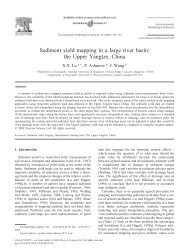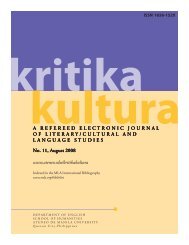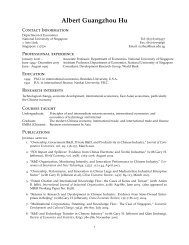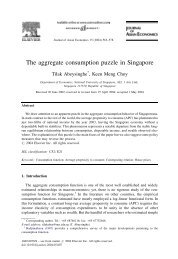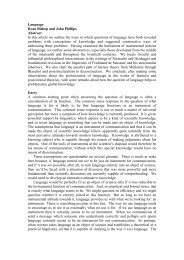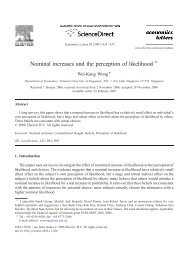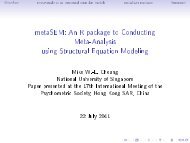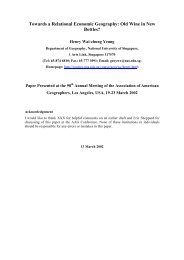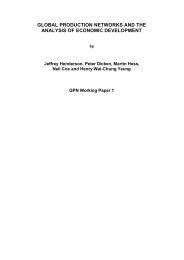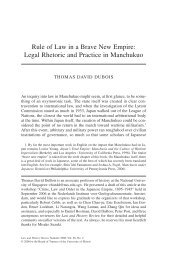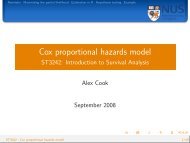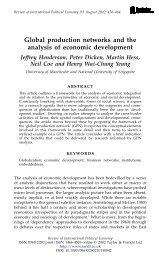Researching Hybridity in Social and Economic ... - NUS Home
Researching Hybridity in Social and Economic ... - NUS Home
Researching Hybridity in Social and Economic ... - NUS Home
You also want an ePaper? Increase the reach of your titles
YUMPU automatically turns print PDFs into web optimized ePapers that Google loves.
<strong>in</strong> Hong Kong <strong>and</strong> S<strong>in</strong>gapore <strong>and</strong> a large collection of <strong>in</strong>terest<strong>in</strong>g vignettes that can be further<br />
developed <strong>in</strong>to qualitative case studies. In this way, I have managed to bridge the quantitative-<br />
qualitative divide <strong>in</strong> exist<strong>in</strong>g research of Ch<strong>in</strong>ese capitalism by collect<strong>in</strong>g both k<strong>in</strong>ds of data<br />
<strong>in</strong> a s<strong>in</strong>gle <strong>in</strong>terview survey. This procedure thus m<strong>in</strong>imizes the usual methodological<br />
problem of collect<strong>in</strong>g large amount of quantitative data through highly impersonal postal<br />
surveys of which we have no idea who have really completed those questionnaires. It also<br />
circumvents the messy problem of analyz<strong>in</strong>g qualitative data collected from very open-ended<br />
form of personal <strong>in</strong>terviews (see Clark, 1998; Alvesson, 2003). My <strong>in</strong>terview surveys<br />
therefore allow for a comb<strong>in</strong>ation of quantitative analysis <strong>and</strong> qualitative case studies of<br />
empirical data from the same sources (i.e. same <strong>in</strong>terviewees).<br />
Meanwhile, a large amount of secondary data exists <strong>in</strong> the form of media <strong>in</strong>terviews,<br />
biographies, oral histories, company documents, <strong>and</strong> research reports (see Figure 1). These<br />
secondary data can sometimes be very useful as a start<strong>in</strong>g po<strong>in</strong>t to identify different k<strong>in</strong>ds of<br />
actors <strong>in</strong> “Ch<strong>in</strong>ese” bus<strong>in</strong>ess networks. For example, the media often has special access to<br />
many lead<strong>in</strong>g actors <strong>in</strong> Ch<strong>in</strong>ese capitalism because they are well connected <strong>and</strong> will<strong>in</strong>g to talk<br />
to reporters. These elite actors may be less likely to talk to researchers who, as McDowell<br />
(1998) <strong>and</strong> Herod (1999) have observed, have little to reciprocate (see also Welch et al.,<br />
2002). Published reports may have some <strong>in</strong>terest<strong>in</strong>g reports on specific bus<strong>in</strong>ess deals <strong>and</strong><br />
their underly<strong>in</strong>g relationships. Power relations <strong>in</strong> global f<strong>in</strong>ancial markets tend to favor well-<br />
known credit-rat<strong>in</strong>g agencies <strong>and</strong> <strong>in</strong>ternational bus<strong>in</strong>ess media that often have very good<br />
access to large Ch<strong>in</strong>ese bus<strong>in</strong>ess firms. In spite of their potential bias towards transactional<br />
recommendations, these reports on specific Ch<strong>in</strong>ese bus<strong>in</strong>ess firms or actors can sometimes<br />
be very <strong>in</strong>sightful. For example, <strong>in</strong> Olds <strong>and</strong> Yeung (1999), we used a confidential company<br />
report from a credit rat<strong>in</strong>g agency to analyze the proposed corporate reorganization of the<br />
largest Ch<strong>in</strong>ese bus<strong>in</strong>ess conglomerate from Hong Kong – Li Ka-sh<strong>in</strong>g’s Cheung Kong<br />
19



